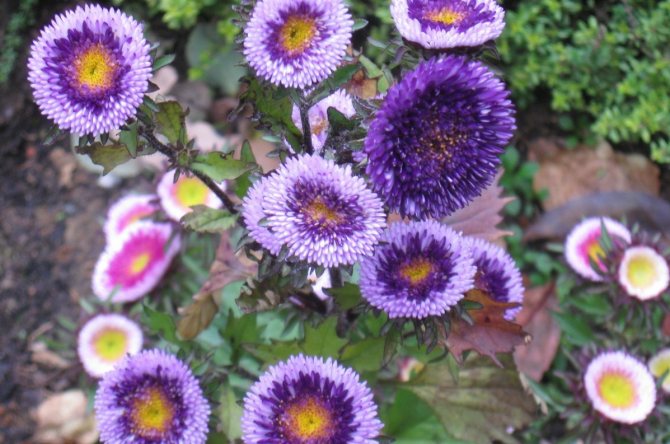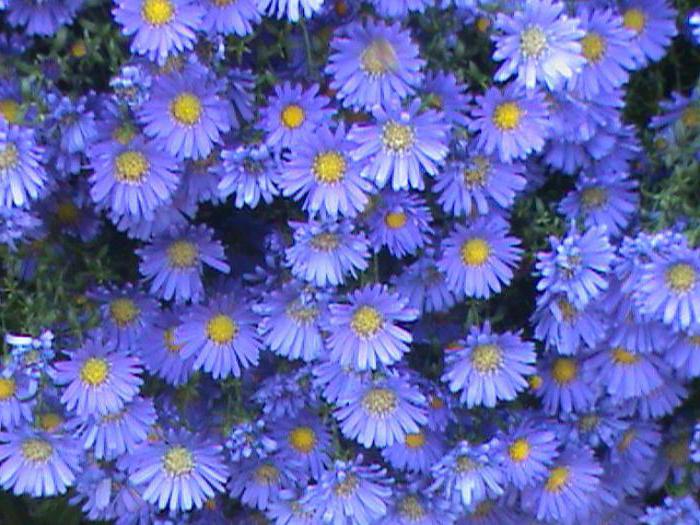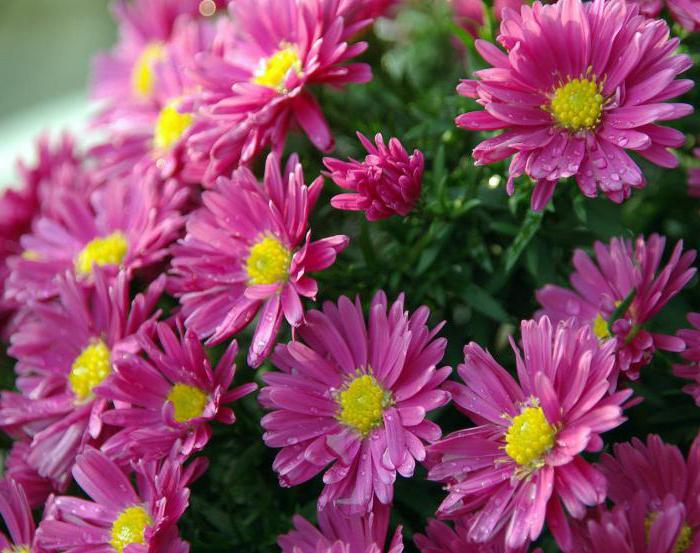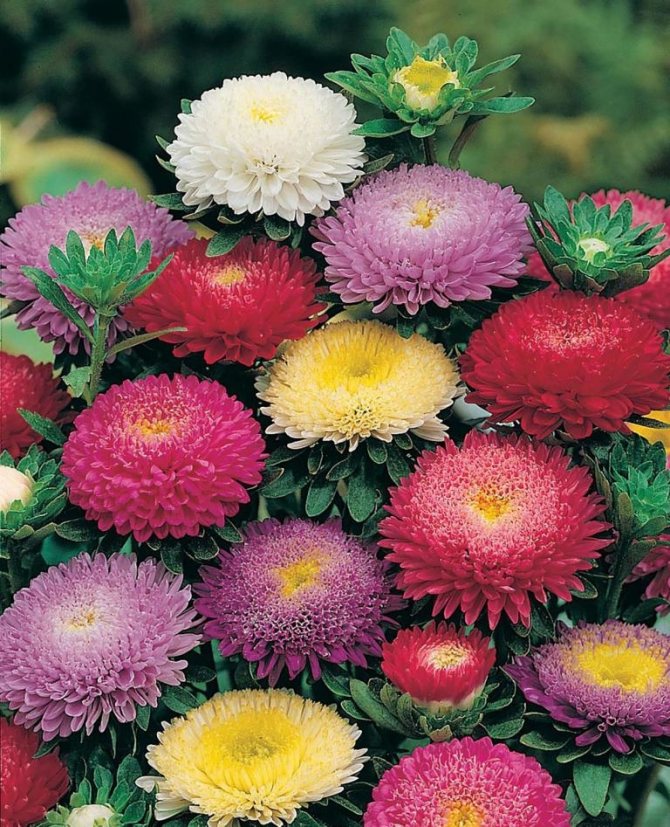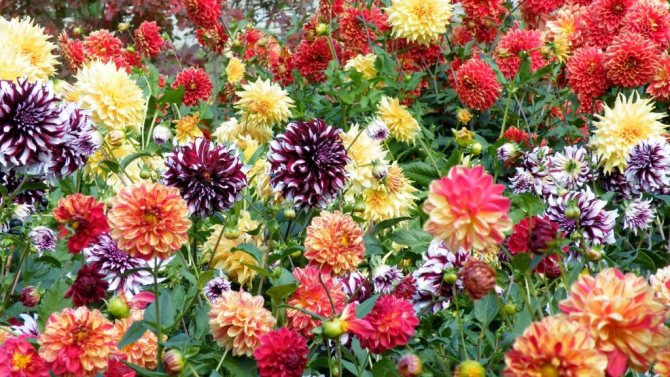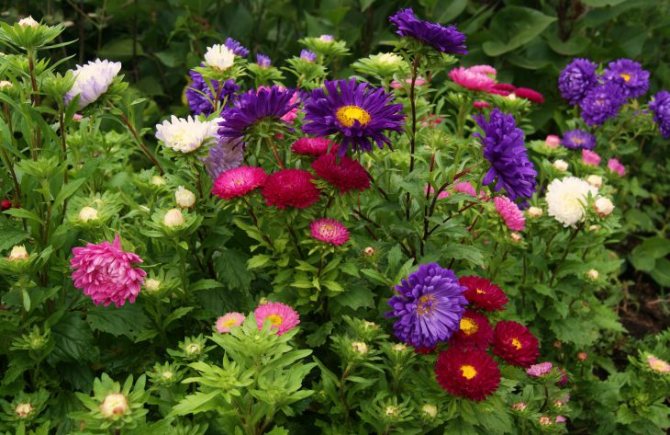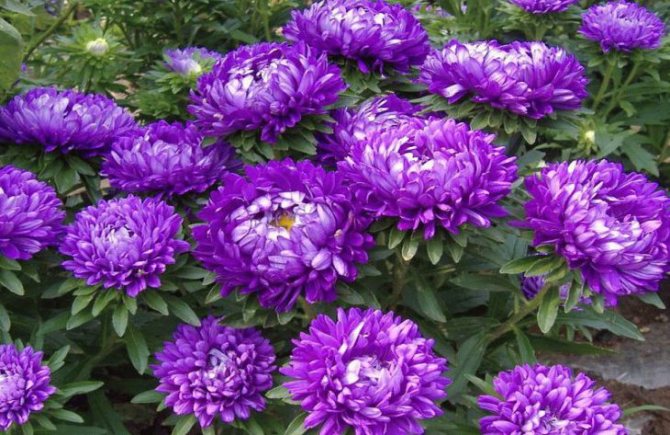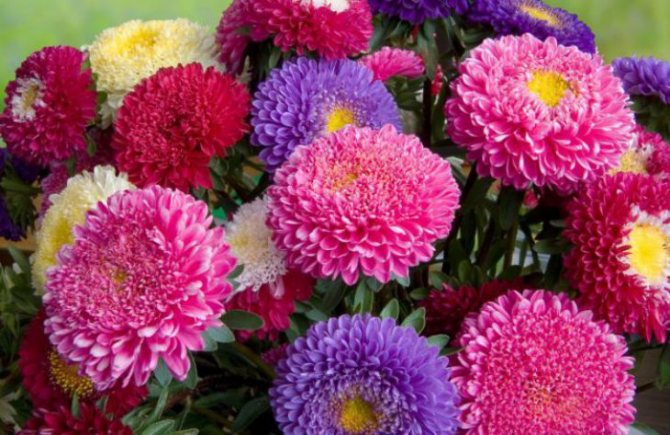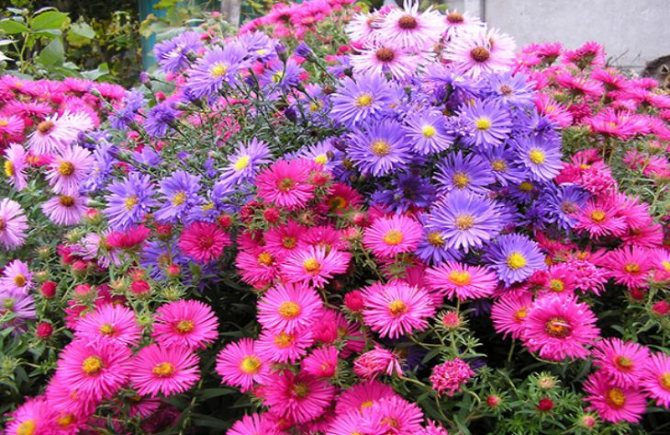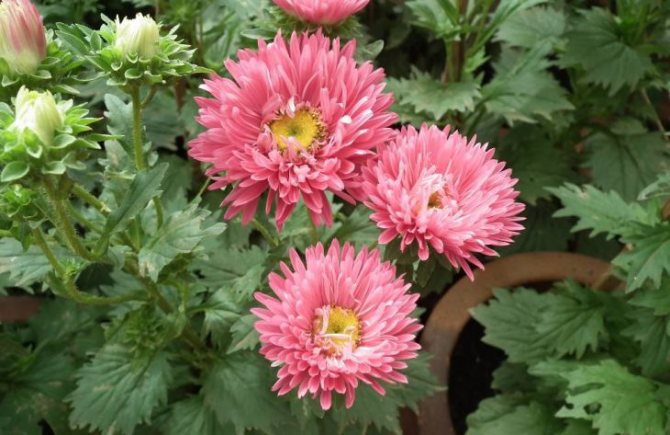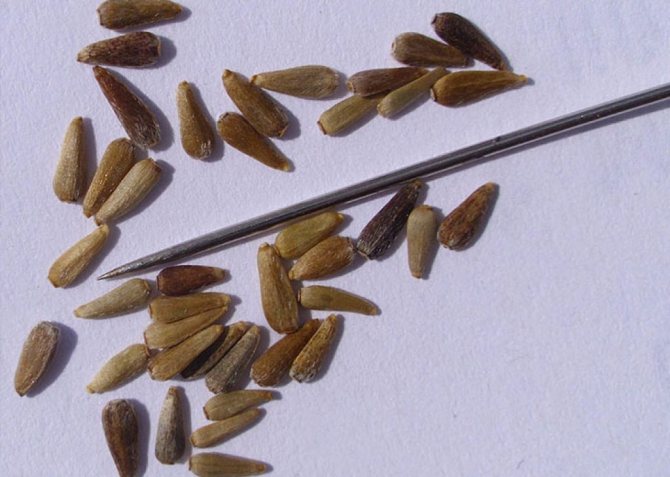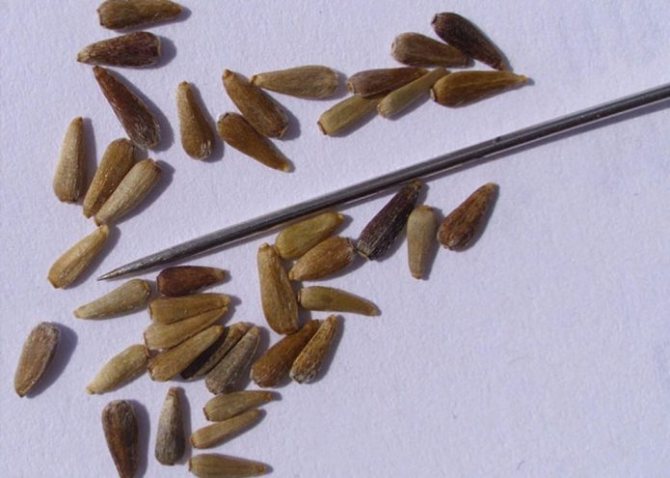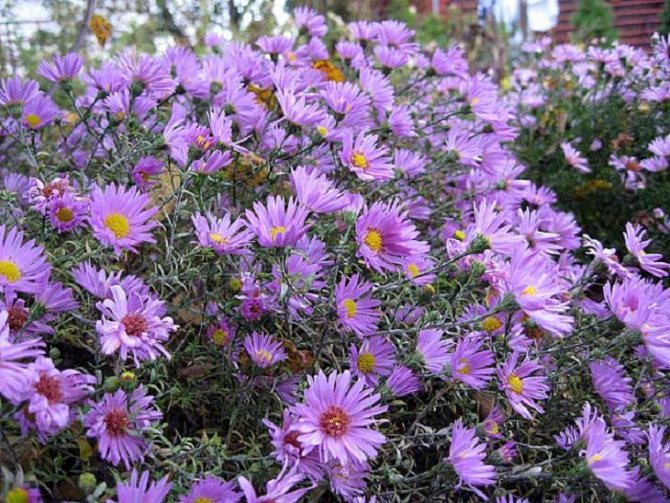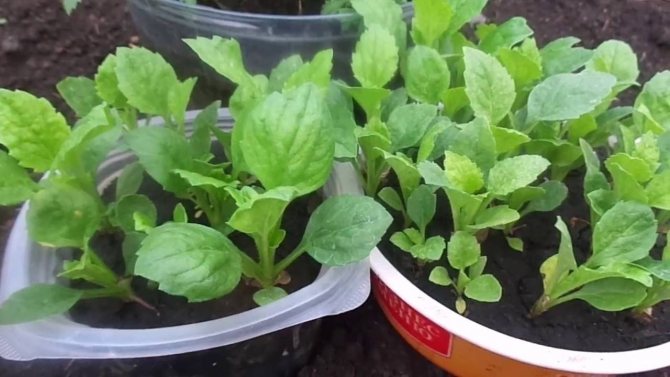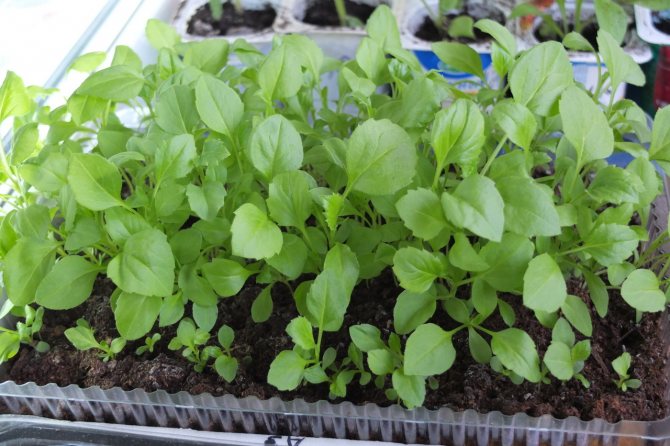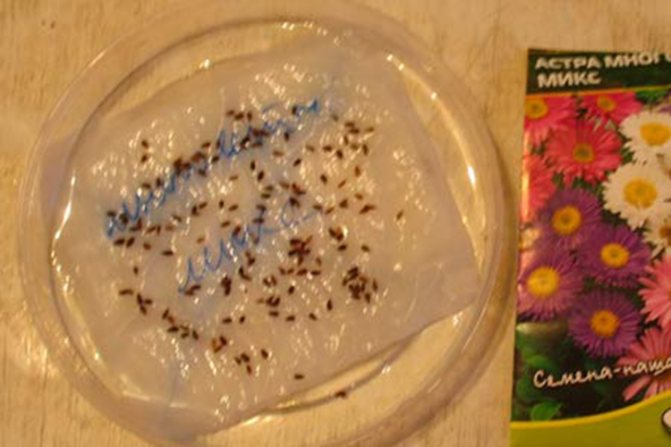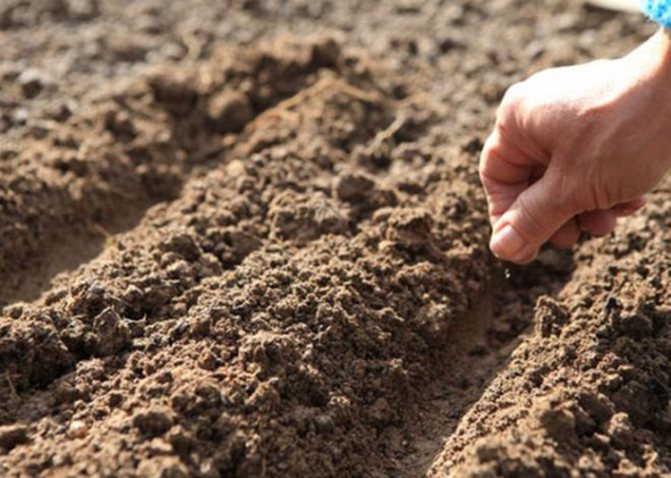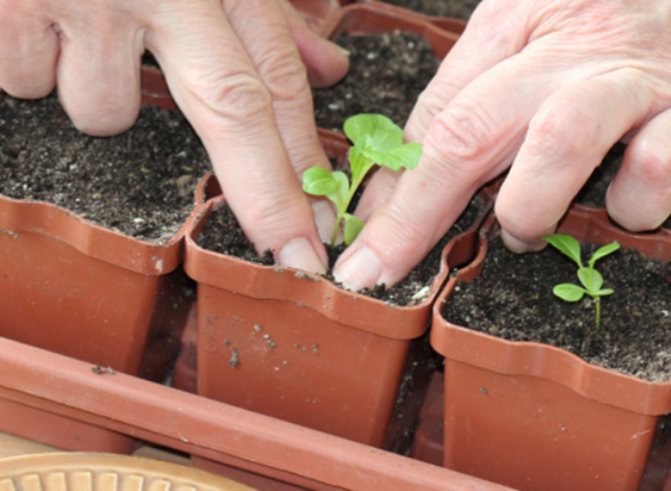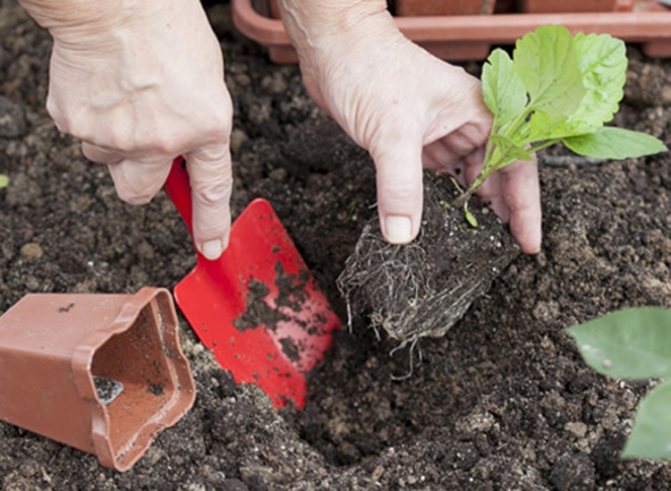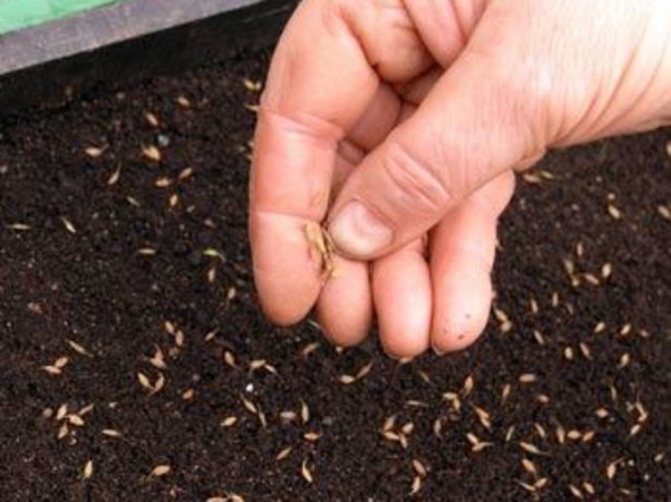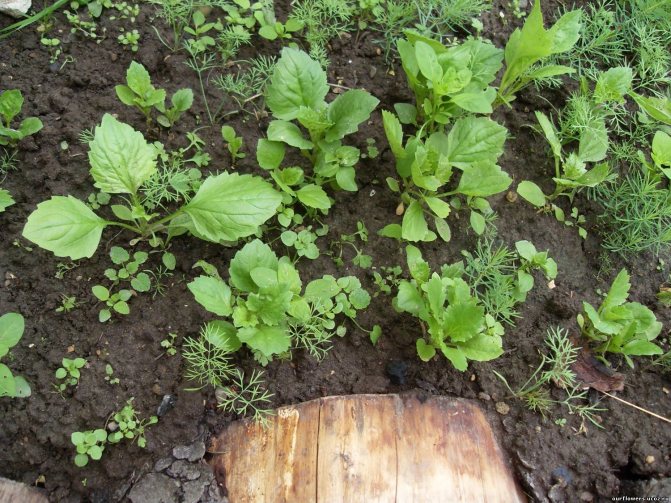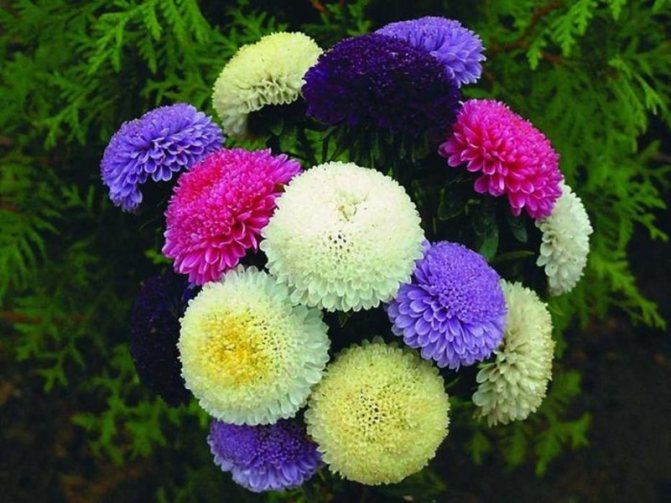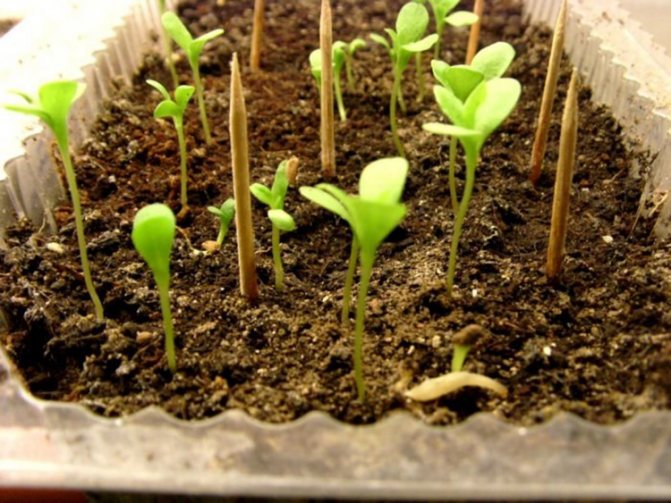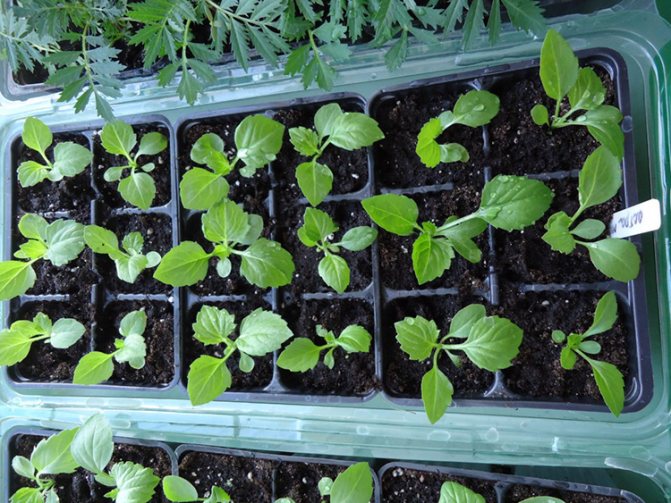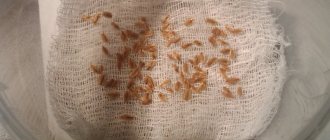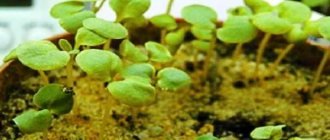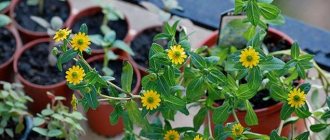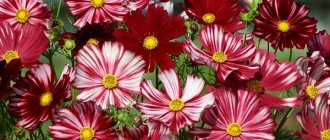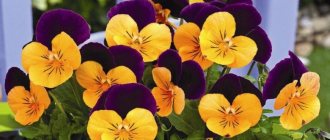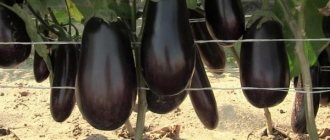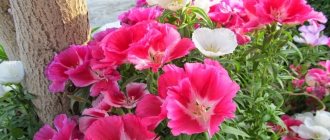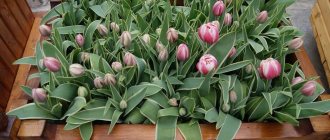Aster is one of the most common flower crops among Russian gardeners. Planting an aster in the open field will not cause much difficulty even for novice flower growers. Unpretentiousness, easy care of the plant, long flowering make this flower a desirable decoration for any garden.
The homeland of the aster is the Far East, Korea, China. In another way, the annual aster is called Callistephus Chinese. This plant is quite cold-resistant and light-loving enough. The successful cultivation of asters will be ensured by a low air temperature and optimal soil moisture. Astra prefers light soil, with weak acidity.
Advice
When preparing the soil for planting asters during autumn digging, you can add humus or compost. In no case should manure be fertilized, its introduction contributes to the infection of plants with Fusarium!
Aster varieties differ in the size of the flower baskets and the height of the stems. Tall varieties are good for cutting into a bouquet, undersized and small-flowered varieties will perfectly decorate flower beds and lawns. You can also plant asters on balconies and loggias.
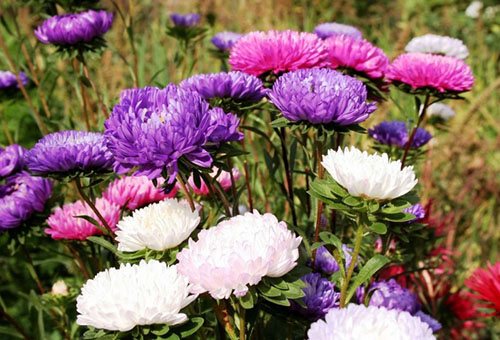
Origin
Aster comes from East Asia, and was brought to Europe in the 18th century by a camel caravan. Then the flowers made a long way through the entire territory of Siberia, got to the European part of Russia, and then were brought to Moscow. And from Moscow, asters directly ended up in the royal gardens of France. There flowers immediately gained special popularity and thus became famous all over the world.
In those days, the so-called language of flowers was popular in French houses. In this language, the aster flower meant "the versatility of love." Having presented such a flower to a lady, the gentleman thereby said that his love for her is multifaceted.
In the Czech Republic, where aster is also popular, it is called the autumn rose. Even in Ancient Greece, asters were credited with magical protective power. That is why most often these plants were planted in front of temples or in front of the houses of noble people. Also in ancient times, asters were used to decorate clothes and hairstyles. In ancient China, asters were called "stars on earth." The Chinese flower symbolizes modesty, tenderness, grace. And in the popular teaching of Feng Shui, it is love and tender feelings.
The scientific name of the flower is calistefus, which means "beautiful crown" in Latin. This is not surprising, because it begins to bloom in the fall, when everything around has almost faded and lost its attractiveness. Today it is difficult to find a plant that would have as many different species and colors as an aster. Currently, there are about 4 thousand species of this flower. Due to the varied colors and the abundance of varieties, growing this flower on your site is becoming a very popular activity.


The most popular varieties with photos
- Princess Mix.
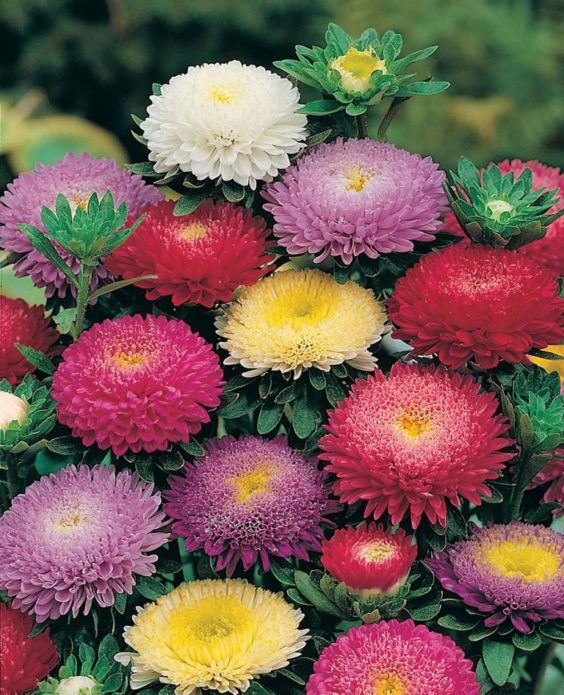

- Blue Moon.
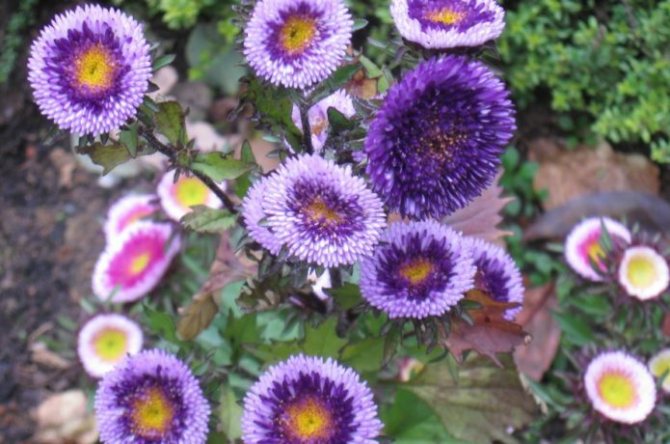

- Supreme.
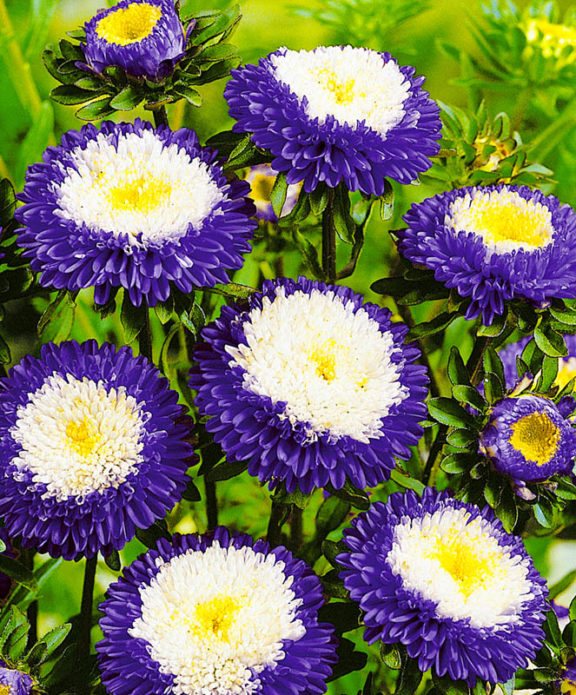

- Winter cherry.
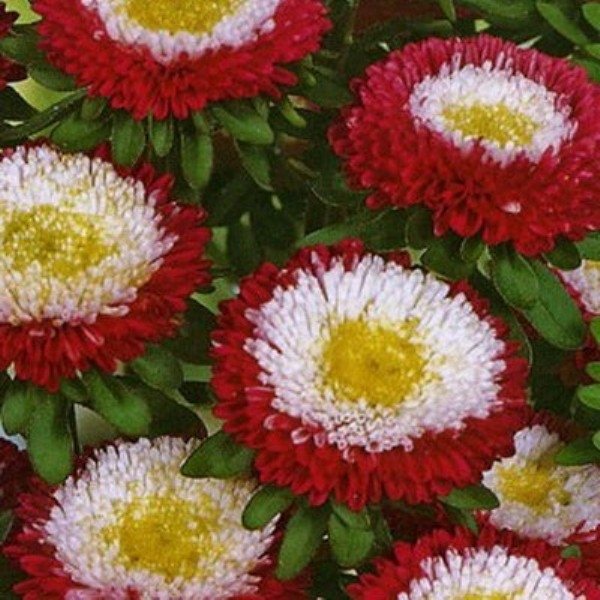

Description and appearance
Today, a wide variety of varieties are presented on the market, as well as in flower shops. Each of them has its own way of growing. Flowers are striking in their uniqueness, variety of shapes and colors. Most aster varieties (over 500 species) grow wild in North America. On the territory of Russia there are only 26 varieties of asters.
All aster varieties can be divided into three types:
- dwarf;
- American;
- italian.
Soil and container preparation
As seedling containers you can use a box or container. If you have several varieties of asters, it is better to plant each in a separate container. Juice bags, in which you need to make drainage holes, are perfect (see photo). A pallet can be a box, the bottom of which is covered with a bag.
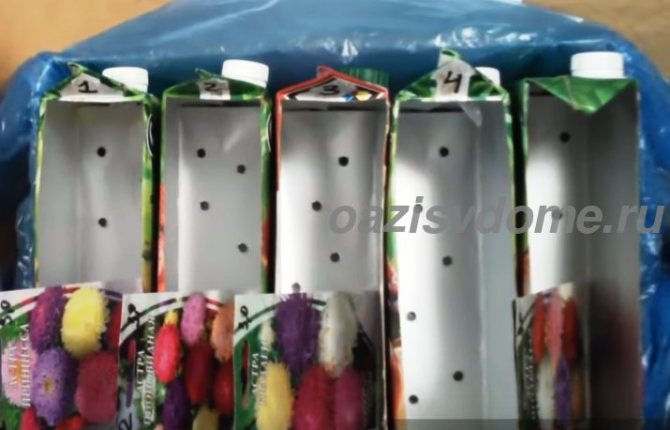

Soil for asters should be loose, slightly acidic. You can prepare it from the soil for azaleas and nutritious neutral soil. To make the soil mixture loose, it is mixed with fine vermiculite.
Dwarf asters
Today, dwarf low-growing asters (we will consider growing from seeds later) can rightfully be considered the most popular and demanded type of flowers on the market. All types of this plant grow in lush bushes, the height of which reaches from 30-150 cm. The size of the flowers of dwarf asters reaches 3-5 to 1 cm. Most often they are used for landscaping balconies, as well as for growing in pots. Also, this species is especially popular among landscape designers (especially perennial alpine aster, growing from seeds of which is not at all difficult).
The most popular varieties of dwarf asters:
- Ada Ballard.
- Beechwood Rivel.
- Astra Milady (considered one of the best and most popular varieties of dwarf asters in the world).
- Alpine aster (growing from seeds is described below).
- Erfurt dwarf.
Stratification
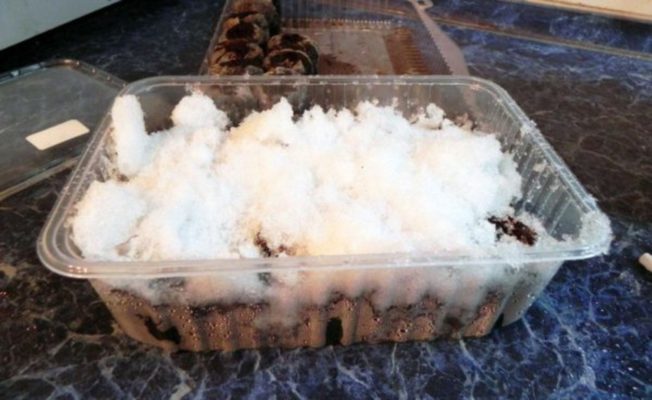

Most experts recommend using the stratification method when growing a peony aster. This method is the use of contrasting temperatures to improve seed germination.
The planting material must be spread out on the ground and sprinkled with a 1 cm layer of snow. Then the container must be placed in a cold place for several hours, and then rearranged into a warm place. This alternation of temperatures should be carried out up to the time the seeds hatch. As soon as seedlings appear, they must be moved to pots or peat tablets.
American asters
Most often they are called New England asters. They are very hardy and frost-resistant perennial flowers. This species is not susceptible to parasites such as powdery mildew. Watering such asters is recommended once a week. These flowers grow and multiply very quickly. The height of the bushes can reach 2 m. The diameter of the flowers is about 4 cm. This species begins to bloom at the end of summer, and ends with the first frosts. Light morning frosts for this type of asters are not at all scary.
The most famous varieties of American asters include:
- Bars Pink.
- Rubishats.
- Constgans.
- Dr. Ekener.
Legends about the origin of flowers
There are legends associated with many things that exist on our planet. Flowers are a separate world, which has always been an object of admiration for a person. Their beauty evoked the brightest feelings that prompted people to compose romantic stories. But who knows, maybe some of this is true. Asters are beautiful, and there are legends about them, we will tell you two of the most common.
The first legend says that one day the Taoist monks decided to find a path that would lead them to the stars. They took a thorny road that was full of difficult trials. The monks were left exhausted, their legs were bleeding from wounds. But suddenly they saw a clearing where there was a lake. The travelers decided to rest there and gain strength, but among all the vegetation they saw wonderful flowers - asters. Then the monks realized that there is no need to look for the stars in the heavens when they are here - in our world. They collected aster seeds as gifts and germinated.
For information! In Latin, an aster is a star. Flowers on earth have been known for hundreds of years and come in many varieties.
The second legend is more mythical because it comes from Ancient Greece. The daughter of the goddess Demeter was given in marriage to Hades - the ruler of the underground and gloomy world.The young girl was doomed to go underground and live there every autumn and winter. The goddess was unhappy, and one day she saw a couple in love, which she could not achieve. She burst into tears and the tears that fell to the ground sprouted, and as you understand, they were asters. Well, we move on to more essential things and talk about how to grow these beautiful flowers.
Italian asters
In another way, they are called chamomile, or European asters. It is a perennial plant. This species is especially popular in France and Italy, as well as in some countries of South-Eastern Europe and Western Siberia. The diameter of the flowers reaches 5 cm.
The most popular varieties include:
- Heinrich Seibert.
- Rose flower.
- Herman Lena.
Among annual asters, there are also a lot of popular varieties. On the plots, Chinese asters are often grown from seeds. Flowers differ in a variety of petal shapes, color, plant height. It is popular among summer residents to grow pion-shaped asters from seeds. The structure of the flowers is very similar to the peony. The shape of the buds is vaulted and spherical. The bush itself reaches a height of 40-50 cm.
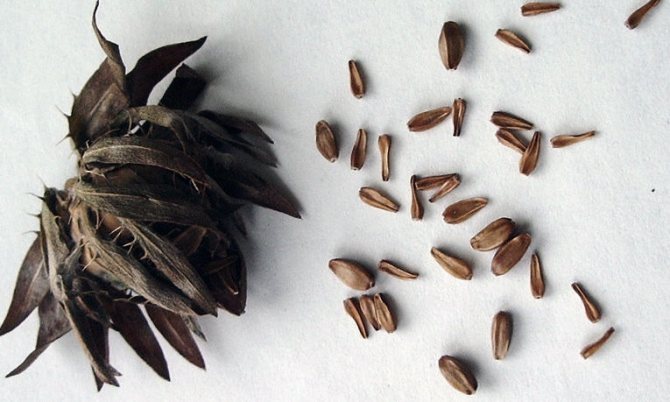

The pompon aster looks very beautiful (growing from seeds and when to plant is described later in the article). Flowers are double, flat, rounded. The bush itself is low, it looks decorative and beautiful in flower beds.
Consider now how and when to plant asters, growing from seeds.
Description
All plants are made up of the same parts: roots, stems, leaves, flowers and fruits. Botanical description of flowers allows you to find out what distinctive shapes, sizes and colors are characterized by each part of the culture. Astra pomponnaya also has its own varietal characteristics:
- The roots of the pompon aster are widely branched, fibrous, superficial, the depth of occurrence is no more than 25 cm, can quickly recover from damage.
- Stems - erect, strong, have longitudinal grooves, covered with fine fine hairs, their color is light green or with a pink tint (depending on the variety). The height of the plant varies from 20 to 90 cm, many processes are formed on the stem, which makes the bush thick and splendid.
- Aster leaves are pompom-shaped, dark green saturated color, small-sized leaves are located in the upper part of the stem, large ones are closer to the ground.
- Flowers are basket inflorescences, along the outer circle of which the petals in the form of tongues are located in several tiers, the inner circle is filled with thin petals-tubes, which stand straight, tightly pressed against each other. The color of flowers is determined by the varietal affiliation; in some cases, mixes of the same variety, but of a wide variety of colors, are created. Their diameter is from 4 to 8 centimeters.
- The fruit of the pompom aster is a cone-shaped seed capsule that stores seeds of different sizes, it depends on the variety of asters.
- The culture propagates, like all annual plants, only by seeds.
On a note! It is worth noting that pompon asters can reproduce by self-seeding. Gardeners who have already allocated a certain place for a flower bed with asters do not waste time growing seedlings.
In the fall, the seed pods open, the seeds fall into the ground, winter well and germinate again in the spring. In this case, the flowering of the pompom aster is early, it is only necessary to thin out the bushes sometimes.
Preparing seeds for planting in the ground
Absolutely all types and varieties of asters are not recommended to be planted directly into the ground. In order for a beautiful lush bush to form from the seeds, the seeds must be prepared for planting in advance. All planting material must be treated with a fungicide solution or potassium permanganate. Several cotton pads must be placed in a container with a solution. Then you need to place the seeds on top and leave in this form for 25 minutes. It is important that the aster seeds are completely in solution. Then they must be thoroughly rinsed with running water.The seeds are now ready to plant.
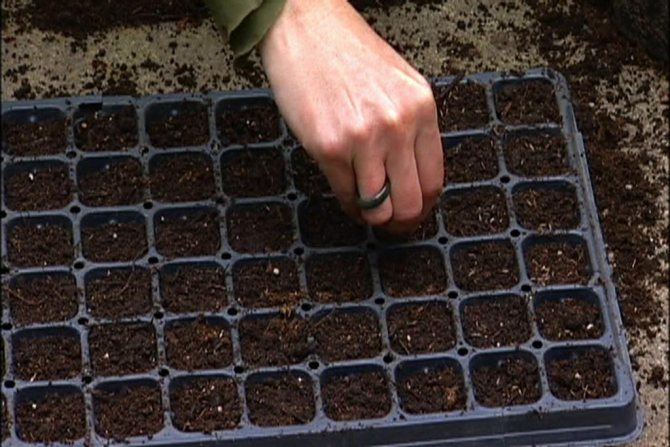

Cuttings
This is the most popular and common method of planting and breeding asters. Preparation for it begins in the spring, when young shoots are just emerging. Cut off the tops of the shoots about fifteen centimeters long so that the bottom cut is oblique. The lower leaves are removed completely, leaving only two or three upper leaves.
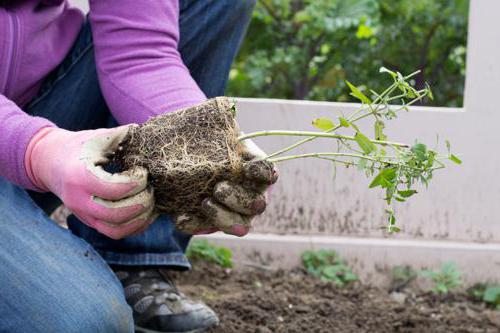

Before planting in the ground, the cuttings should be held in a growth stimulator, in accordance with the instructions. Then plant them in the soil (at an angle!) In a special shelter with a film. For this, partial shade is suitable. Rooting usually takes place within a month. The ideal potting mix in this case is peat, sand and turf. Experienced flower growers recommend treating the substrate with potassium permanganate. In this position, the cuttings are left until next spring for rooting, and then transplanted to a permanent place.
Landing
You should not immediately plant seeds in open ground, not all plants take root in this way. In any flower shop, you can buy quality soil for planting flowers. It is not necessary to cultivate or fertilize such soil, all these procedures have already been done by the manufacturers of this product. Before you start growing asters from seeds at home, the soil must be poured into a seedling container, then slightly moistened. Next, you should evenly distribute the seeds and sprinkle with earth on top. There is no need to sprinkle them too much. After all that has been done, the container with the seedlings must be covered with a clean film that will keep the soil moist.
The first shoots begin to appear in 5-7 days. After that, the film can be removed.
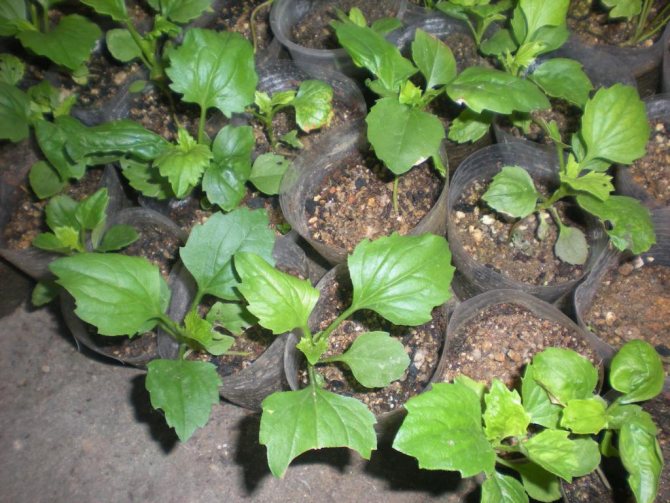

How to sow: step by step instructions
This type of flowers has a long growing season: early varieties begin to bloom 3 months after sowing, late varieties - after 4 months. Therefore, asters prefer to grow seedlings. On the other hand, when growing pompom asters from seeds, sowing directly into the ground saves you a lot of worries and hassle. When sown before winter, the seeds are stratified in natural conditions. Plants grow stronger. When sowing in spring, stratification helps to increase seed germination and survival.
Seedling method
Growing seedlings is a more time-consuming method than non-seedling, but it is more reliable and gives good results in terms of germination and survival rate.
Seeds for seedlings are sown in boxes with a loose plant substrate or directly into the soil of the greenhouse.
Before planting, the seeds can be stratified: wrap in a damp cloth, refrigerate overnight. and keep warm during the day. Repeat this for a week. After the sprouts appear, the seeds can be sown.
Instructions for planting asters for seedlings:
- Germination. 7 days before planting, the seeds are soaked in a weak solution of potassium permanganate for 2 hours, washed and placed in a warm place on a damp cloth.
- Soil preparation. Fertile soil, peat and sand are mixed in proportions 1: 1: 1. The soil is light and loose.
- Disinfection of soil. The soil must be disinfected with a solution of fungicide or potassium permanganate.
- In the soil, grooves are made with a depth of 2 cm, the hatched seeds are carefully placed and sprinkled with sand.
- After planting, the seeds are watered with a weak solution of potassium permanganate through a sieve or sprayed with a spray bottle.
- The ground is covered with a thin transparent film and placed in a moderately warm place with a temperature of up to + 22 ° C.
As soon as shoots appear (usually on days 4–5), the film is removed, and the boxes are moved to a brighter and cooler place. The optimum temperature is + 16 ° C.
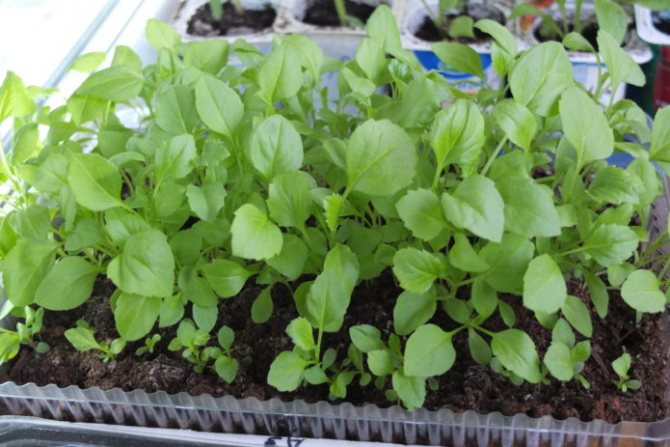

Growing seedlings and transplanting into open ground
Seedlings need regular moderate watering and preventive treatment against the black leg with a solution of potassium permanganate after one watering. Do not overmoisten the soil.
When 3-4 true leaves appear, it is time to pick. At this point, the central root should be shortened by a third. The seedlings are transplanted into a large box, pots, or greenhouse soil. When planting in boxes and directly in the greenhouse, the distance between plants is 5–7 cm. Seedlings of pompon asters perfectly tolerate transplanting.
The first feeding is carried out a week after the picking of the plants. For example, it can be potassium humate and nitrophoska, taken in 1 tsp. for 2 liters of water. Further, the seedlings need to be fed every week until they are planted in open ground.
If it's warm outside, the seedlings can be hardened before planting. Every day, the time spent on seedlings in the open air needs to be slightly increased, you should start with half an hour.
Asters love light and do not tolerate stagnant water well, so you should choose a bright and as even place for them so that the water does not stagnate during irrigation and after rain.
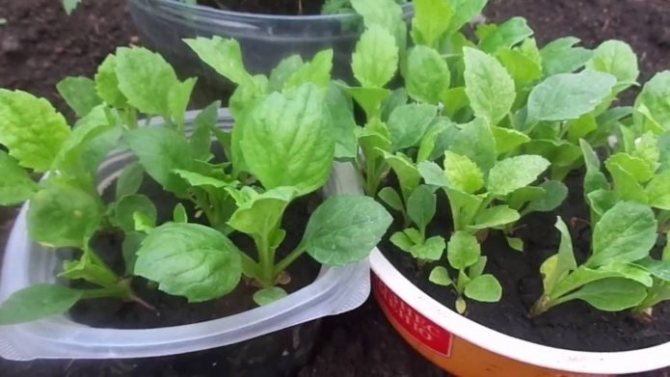

Seedlings of asters are planted in the ground at the age of about one and a half months. Before planting, you should make sure that the plants have 8 leaves, the root system is well developed, the stem is strong, and its length is 10 cm or more. Planting is carried out in the evening, grooves should be prepared in advance and filled with water.
The spaces between the grooves are 50 cm, between the flowers - 15–25–35 cm, depending on the size of the flowers of an adult plant and the height of its stem.
Instructions for transplanting seedlings to a permanent place:
- Weed the selected flower bed.
- Loose the ground to a depth of 6 cm.
- Water the seedlings in pots or boxes.
- Make holes or grooves in the flowerbed according to the size of the seedling containers.
- Water the soil.
- Transplant seedlings to a prepared place.
- Cover with dry earth. No need to water.
- After 10 days, add nitrogen-containing fertilizers to the wells.
After 2-9 weeks after planting, fertilizing is carried out with a complex fertilizer, the next time it is fed after 4 weeks.
Sowing seeds in open ground and caring for seedlings
Pom-pom asters can be planted in winter, while the seeding rate is increased compared to the spring by ⅓ and the freshest seeds with high sowing qualities are selected, which have been stored for no more than 2 years.
For 2 weeks, the seeds are soaked in a solution of potassium permanganate of medium concentration and then thoroughly dried. Before winter, the planting depth is reduced by 2 times, that is, the depth of the grooves will be 2 cm. With the onset of persistent cold weather, dry seeds in dry weather are sown in prepared grooves, while the soil should already be frozen. Then the grooves are mulched with peat to prevent crust formation after the melt water has escaped. The thickness of the peat layer is 3 cm.
If planting is carried out in the spring:
- In the prepared soil, grooves up to 4 cm deep are marked at a distance of 0.5 m from each other and seeds are planted in them.
- Then sprinkle with earth and watered. At night, planting is covered with a film. to save from night frosts. The film is removed after germination and returned only if there is a possibility of a sudden cold snap.
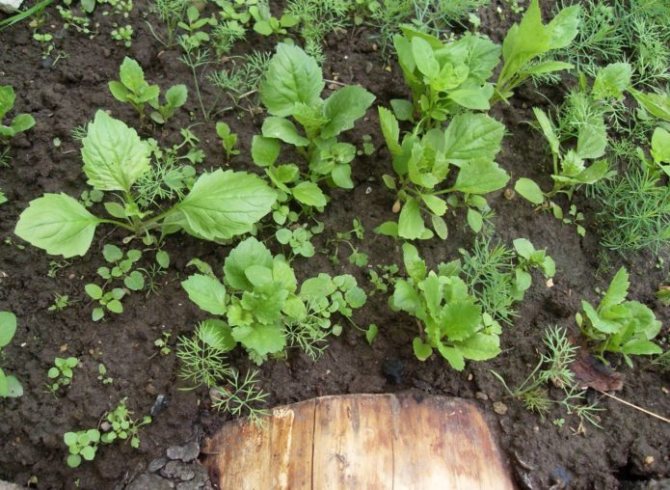

When the asters have 3 real leaves, the plantings are thinned out: the extra plants are removed so that the distance between the remaining ones is from 15 to 20 cm.Excess asters can not be pulled out, but carefully dug up and planted in another place.
Further care outdoors
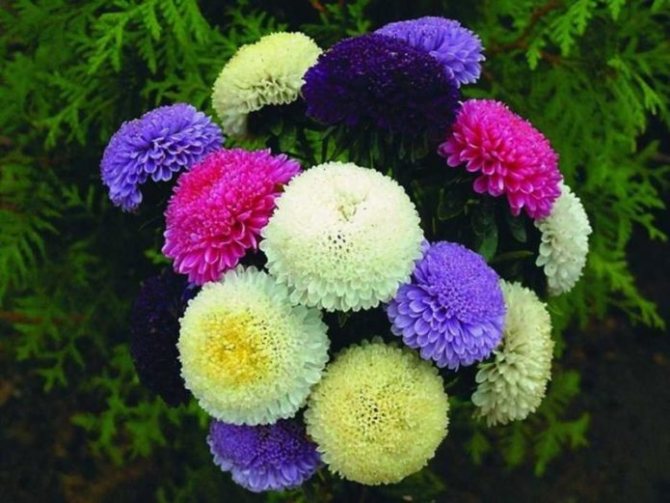

Pompon asters are unpretentious and easy to care for. If fertilizers were introduced into the ground in advance, areas with growing asters will only need weeding and timely watering. For plants to have a strong stem and very large flowers, they can be fed 1-2 times per season: before setting buds and when flowers appear.
Asters do not like flooding the soil and therefore it is recommended to water them when the top layer of the soil is clearly drying out. After watering, the soil is loosened and at the same time weeds are removed. In hot weather, reduce the number of irrigations and increase the volume of water.
Pompom asters are grown by sowing seeds directly into the ground before winter or in spring or by seedling. The choice of planting method depends on the climatic zone. To decorate your site with flowering asters, you need to get to work right now.
American asters: growing and care
Growing from seeds of perennial asters is carried out in sunny areas, asters are not very fond of the shade. It is desirable that the soil is loose and rich in trace elements. Flowers of this type do not need frequent watering. A slight drying out of the soil is tolerated normally. It is better to water the flowers in moderation. American asters do not require frequent fertilization. Fertilizing with potassium and phosphorus is necessary only in the spring. For the rest, the flowers have enough of those trace elements that are contained in the soil. If you periodically remove all dried leaves and flowers from the bush, then the plant will bloom until late autumn.
With the first snow, the bush will need to be cut. All shoots must be cut very low. Only stumps with a height of 3 cm should remain from the bush.As already described earlier, this type of aster is not susceptible to pests. Flowers reproduce by division. You can always dig out some of the roots with shoots from one bush and transplant it to another place. Aster division is very well tolerated.
Seedling care
After a week, the first shoots will be visible. It should be noted that the correct planting of asters on seedlings will not bring the desired result if good care is not organized. As the culture grows, a pick is carried out. This procedure involves transplanting seedlings into separate pots. Asters are planted when several real leaves grow on the stems. The seedling needs to be strong enough.
The essence of the pick is as follows. The soil is poured into the container and a small depression is made with a stick. The plant is buried in the soil, without reaching the leaves. Seal and press gently. They are placed in a warm place with diffused light.
Regardless of the variety, caring for asters involves a number of activities:
- Irrigation. Watering should be done sparingly, avoiding getting water on the leaves. You cannot fill in the culture. Sprinkle with warm water from a spray bottle. But if there is no such device, then watered, starting from the edge of the pot to the center. It is required to ensure that no crust appears on the surface of the soil.
- Good lighting. Placed on a window where there is no direct sunlight.
- Temperature. The value must be maintained at +20 degrees.
- Top dressing. They are shown in the event that the soil is not enriched with useful substances. Mineral fertilizers are used, which must include phosphorus, nitrogen, potassium, and iron. These mixtures include Fertika, Agricola and Solution.
- Hardening. It is carried out in relation to dived plants. When the bushes are well formed and gain sufficient deciduous mass, they are placed on an open window or taken out to the balcony.
Dwarf asters: growing and care
Most often, asters of this type are found in pink and red shades. Purple is the least common. The cultivation of asters of this species from seeds is unremarkable. This species is unpretentious in watering and feeding. Flowering begins in mid-July and lasts until September. Dwarf asters are biennial plants. This type of flowers is most optimal for balconies landscaping. There is no need to fertilize plants with natural ingredients (manure, humus). Asters of this type need to change landing sites or soil every year (if it grows in balcony boxes).
Planting asters with seeds
This method of growing asters is only suitable for the alpine variety, in the case of the rest it is ineffective. This is due to weak seedlings, which do not take root well. Seeds of perennial asters are sown in the fall, immediately after they are harvested. But spring is more suitable for alpine aster sowing, when the soil warms up well.With the onset of stable heat, the first shoots appear, and in the fall, young plants are transplanted to a permanent place.
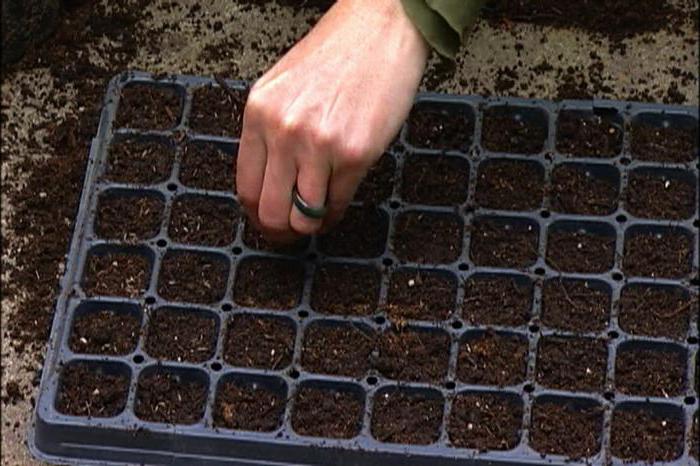

When the first shoots sprout, the plant requires abundant watering, loosening and feeding. In one place, a perennial aster should grow no more than five years, after which it is transplanted.
Italian asters: growing and care
Italian asters are the most beautiful of these flowers. Inflorescences are in the form of a hemisphere. But this species blooms very little. Mid-July to September. The plant loves sunny places and calcareous soils. Growing asters from seeds is not difficult. This species is unpretentious in its care. Flowers need to be watered periodically in moderation, as well as loosened. It is necessary to fertilize the plant no more than those times during the entire flowering period. One of the clear advantages of this species is the ability to maintain a fresh look for a long time. Italian asters can stand in a vase for more than one day.
Diseases and pests
Growing seedlings of asters is associated with the risk of infection of plants with fungal diseases. The most common infections include fusarium and rust.
Rust in asters appears in the form of yellowish-brown spots that cover the leaves of plants. They appear on the underside of the leaves and gradually dry out them. If measures are not taken in time, the plant may die. Moreover, even if it is possible to cure the flower, the spores of the fungus can remain in the soil and after a while again infect the asters.
Flowers diseased with rust are treated with a solution of Bordeaux liquid.
Seedless (winter) method of growing asters from seeds
Today, many gardeners actively use planting seeds in autumn soil in their practice. This planting method is often called seedless. Planting seeds is best in late October or early November. It is recommended to plant in slightly frozen ground. Growing asters from seeds is carried out as follows. To plant seeds, you need to make a bed with well-dug soil. It is also recommended to fertilize frozen soil with microelements. It is best to plant seeds in grooves, at a distance of 2 cm from each other. The garden bed must be covered with plastic wrap until spring. This planting method is most often preferred by gardeners. Plants grown in this way are more frost-resistant.
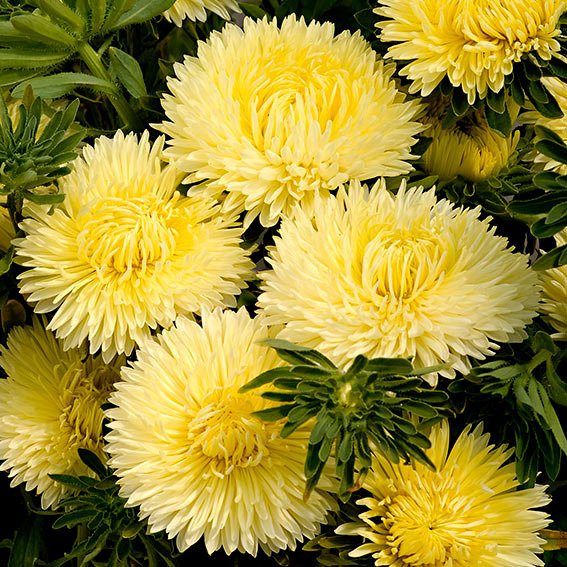

When to sow asters for seedlings
You can plant an aster for growing on a window in an apartment environment at any time of the year, however, when sowing in different seasons, there are certain features of caring for seedlings. For example, asters, sown in mid-spring and summer, develop best. In this case, the seedlings will be provided with a sufficient amount of natural light, since the daylight hours at this time of the year are long.
Asters planted in late fall or winter need extra care. In particular, they require an additional light source and more frequent feeding.
When growing aster flowers with the intention to subsequently move the plants from containers to open ground, it is important to calculate the timing of sowing seeds so that flowering occurs in September. For this, the aster is planted at the end of February-March. In areas with late snowfall, planting can be postponed until April or even May.
In addition, the timing for sowing asters for seedlings is largely determined by its variety. So, for example, there are:
- early varieties that bloom in 85-95 days from the moment the first shoots appear;
- medium ripening varieties - ripen in 100-110 days;
- late varieties - flowering begins on average on the 130th day.
- early bloom 90 days after germination.
Growing difficulties
There are times when asters grow very poorly or die. And there are times when they do not grow at all. This is not a reason to be upset. The expiration date of the seeds should be carefully checked. Or soak the seeds in ash for a day (1 teaspoon per glass of water).If there is no ash on hand, you can soak it in aloe juice (also a teaspoon in a glass of water). It is also recommended to change the soil.
Asters cannot be fertilized with manure. It is not recommended to plant asters in places where tomatoes and potatoes used to grow. It is best to replant asters to a new location each time.
Incomplete inflorescences in flowers are in the case of abundant watering or a lack of potassium.
Preparing an aster for landing: choosing a place
We have briefly described the popular varieties of autumn asters, now it's time to get acquainted with the planting conditions. To get a beautifully flowering plant, you must choose the right place for planting and prepare the necessary soil.
You can grow autumn perennial asters anywhere, but if you want to get lush bushes and achieve active flowering, you need to choose the most suitable place on the site. Astra feels great in open, well-lit areas. Sunlight promotes the development and growth of the entire bush, not just the foliage and stems.
We must not forget that in most cases the choice of a site for planting depends on the variety and type of aster. If you decide to plant several varieties, choose them according to their height. Thus, when the earlier varieties have faded, they will not cover the later ones. Short or dwarf ones are suitable for framing paths, and tall ones look good along the fence.
Diseases of asters
- Fusarium. It is a fungal disease. This disease affects not only asters, but also any other garden flowers and plants. The disease mainly affects mature plants. Stems and leaves weaken, turn yellow and wither only on one side. In order to prevent this disease, it is not recommended to plant asters in the same place all the time. If, nevertheless, the plant has become infected, it is recommended to dig up the affected parts of the bush and take it away from the site or burn it. This disease spreads very quickly to other garden plants.
- The most common fungal disease that affects absolutely all seedlings is called black leg. It begins to develop due to acidic soil. The stems of all seedlings begin to rot and turn black. Diseased plants should be removed immediately, and the affected areas should be watered with fungicide.
- If there are conifers on the site, it is advisable to plant asters away from them. The fact is that rust spores are often formed on conifers. Getting on the leaves of flowers, the spore begins to actively multiply, thereby killing the garden plant. If the flowers do become infected with rust, it is recommended to treat them with Bordeaux liquid (1%) every week.
Brief characteristics of the aster flower
Before planting aster seeds for seedlings is considered, it makes sense to give a general description of this flower. It is a bush that grows, depending on the variety, from 20 centimeters to a meter. The stem is firm and erect, covered with short hairs, with longitudinal grooves. The root zone is widely branched, deepening into the ground by 20 centimeters. The damaged areas of the roots are quickly restored.
The leaf plates are dark green, slightly pubescent, alternate, their shape is oval-rhombic. The length is 3-7 centimeters and the width is about 4 centimeters. The apex of the leaf is pointed. The main stem usually has 6 to 19 leaflets. Inflorescences consist of many reed petals, varying degrees of doubleness. The diameter reaches 20 centimeters. But it mostly ranges from 3 to 11 centimeters. The middle is bright yellow.
Asters are propagated by seed. Sowing is carried out directly on the garden plot, or seedlings are grown and then they are transferred to the ground. In the first option, the buds will begin to form a few months after sowing. But planting asters for seedlings gives faster results.Therefore, the second method is more preferable. Also see the article: Zamioculcas: reproduction by the most effective methods.
How to collect aster seeds
The very first flowers are best suited for seeds. Most often they are the largest and strongest. When the aster flower withers and darkens, a small fluff appears in its center, which must be cut and put into a clean bag. Seeds are best harvested in dry weather. If it rained outside, and the seeds need to be urgently collected, it is recommended to disassemble and dry the flowers. This method will save the seeds from rotting. The collected seeds are usually ripened in a bag.
As already described above, it is not particularly difficult to grow such a flower in your garden or on your balcony. It is enough to follow all the indicated recommendations, and the result will not be long in coming. And the fruits of your work done will delight you and those around you with their bright flowering for a long time.
Other options for obtaining seedlings
For home growing, the seedling method is often used. However, good quality land is not always available. Then apply other options. For example, planting an aster in toilet paper or a snail has worked well.
A method like planting asters in a snail is nothing new. Gardeners have been using this method for a long time. For its implementation, you will need toilet paper moistened with a solution of potassium permanganate, a cellophane substrate. Paper is placed on the substrate, and seeds are placed on top. It is recommended to retreat 1.5 centimeters from the edge. The whole structure is twisted and fixed on the sides, wrapped in a bag. Asters will be in this state until the formation of cotyledons. Then the snail is unrolled, the seeds are covered with soil mixture 1 centimeter thick, moistened with water and rolled up again.
The structure is again placed in a plastic bag. When the sprouts begin to actively develop, the snail is removed from the cellophane and placed on a pallet with a layer of wet sand or sawdust. Irrigation is carried out regularly. When the seedlings become cramped, a pick is performed. This method has obvious advantages:
- Compact arrangement of the structure.
- Convenience of picking.
- Ease of maintenance.
- The ability to easily adjust the temperature and lighting.
Some gardeners use a laminate underlay instead of cellophane. You can buy it at any hardware store. At a cost, it is quite affordable. A regular foam backing 2-3 millimeters thick will do. The material is cut into long strips the width of toilet paper.
Species features
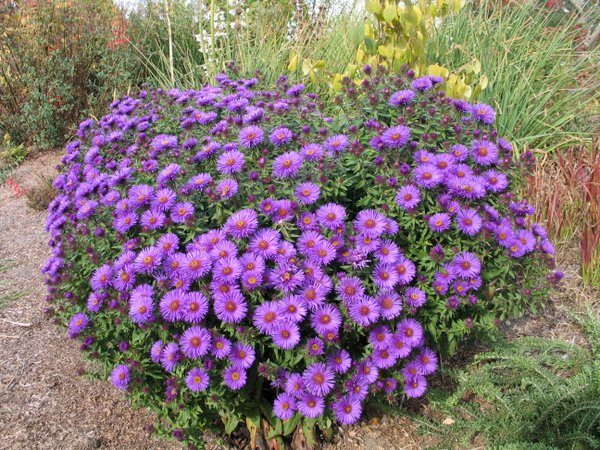

Asters are unpretentious decorative flowers.
Asters are annual and perennial grasses originating from China, growing in the mountainous, forest and steppe regions of Eurasia, North and South America. The genus includes over 200 species, belongs to the Asteraceae family. As for the garden aster known in floriculture, the flower does not belong to the genus Astra, but to the related genus Callistephus.
In floriculture, annual asters are mainly used, less often perennials, which can grow as a single flower or a whole bush. By height, there are high (50–75 cm), medium (from 30 to 50 cm) and low (15–20 cm) asters. A bouquet collected from asters can stand in water for up to 18 days.
Aster flowers of various varieties differ significantly in size (from 3-4 cm to 15 cm), shape (radiant, spherical, needle-like), structure (pink, peony, chrysanthemum). The color of flowers is also varied: white, pink, lilac, red, pale blue, blue and dark purple.
The name of the magnificent flowers is translated from Latin as "stars". The beauty of these stars was appreciated not only by flower growers, but also by artists. Asters in painting are represented by beautiful canvases by Claude Monet, Zhukovsky, Zhdanov and many other masters.
Collecting your own seeds
You can sow both purchased seeds and your own, collecting them at the end of the season as they ripen. It is necessary to collect them when the flowers fade, and its centers darken, covered with white fluff. Such an inflorescence must be carefully removed and wrapped in paper, where it dries up. Do not forget to sign the packet with the aster variety and the date of collection, since seeds must be used for planting no more than two years old. As you can see, it is quite simple to plant asters correctly. Caring for them is also simple. And the variety of colors promises beautiful and lush flower beds in your garden from mid-summer until the first frost.
Summer care


Astra does not take much time to leave. Drought can harm her. Abundant watering is necessary on hot days. Many inflorescences are tied in plants growing on fertile, loose soil. Watering in the morning. Make sure that there is no waterlogging. Stagnant water causes root rot, leading to the death of the flower. Watering during bud formation has a particularly good effect on the beauty and size of the inflorescences.
Astra responds well to root feeding. Apply ash infusion or use mineral fertilizers. Feed the first time after 14 days. Plants will take root by this time, they will start up new shoots. Fertilizers can be applied to the soil before buds appear. Rate per square meter:
- superphosphate - 2 tbsp. l;
- potassium sulfate - 1 tsp;
- ammonium nitrate - 1 tbsp. l.
During flowering, exclude ammonium nitrate from dressings. The use of organic fertilizers is permissible only on very poor soils.
Hilling is recommended for tall plants. An earthen roller, will make it more stable, will give additional nutrition to the roots. Having received more trace elements from the soil, the plant will bloom longer and more abundantly.
Monitor the cleanliness of the soil in the flower beds throughout the season. Remove weeds before the testes appear on them. Loosen the top layer of the earth. The loosening depth is no more than 5 centimeters. Mulching can simplify soil maintenance. Mulch layer: sawdust, dry grass, chopped bark retains moisture, reduces weeds.
During flowering and active growth, you can pinch the tops of the shoots in some varieties of asters. This promotes the formation of side shoots. Be sure to remove faded inflorescences. Monitor the condition of the plant,
Seedless growing method
There is not much to do here. We have already said about the place. Seeds are sown in rows, the soil must be prepared in advance. You can dig a bed, sprinkle humus along the entire length, spill it with an additional complex preparation. After that, the seeds are sown, sprinkled with a layer of soil. At the same time, you can plant both in spring and before winter. In the latter case, the asters will bloom a couple of weeks later, but the bloom itself will be longer.
On a note! Often people ask the question when the asters bloom. There is no definite answer, since it all depends on the variety that you have chosen. Some flowers please only by the end of summer, some can give buds already in May. Usually the dates are indicated on the seed packages.
When using a seedless growing method, the following rules are important:
- if you sow seeds in the spring, then the soil should already be moderately warmed up - late April - early May. In autumn they sow around October under a layer of mulch. It can be sawdust, compost. In the spring, the beds are only weeded around, but the mulch is not touched until shoots appear;
- in both spring and autumn, it is better to spill the soil with boiling water with potassium permanganate - both disinfection and additional heat;
- do not make the beds deeper than 2 cm;
- mark your landings so as not to trample them later or dig them up;
- do not forget to water the area with asters with warm water, but this is done very rarely if the soil has become too dry and it is quite hot outside;
- when the seedlings are about 4-5 cm each, then they need to be planted, it is better to do this in the evening hours and also strictly according to the dates of the lunar calendar.
Pests
- Plowed slug. It feeds on leaves and buds, leaves silvery traces on the leaf plates. To destroy the pest, insecticides are used, weeds are removed.
- Meadow bug. It feeds on plant sap. When a pest attacks, first white dots appear on the leaf plates, then the leaves die off. Prevention and treatment consists of spraying the plant with insecticides.
- Spider mite. Affects the underside of leaves, feeds on sap. Due to lack of nutrition, the leaves become lethargic and yellow. To avoid being attacked by a spider mite, you need to treat the asters with tick repellents.
- Astral blizzard (aka sunflower moth). Small butterfly caterpillars feed on flower petals and pollen. Planting asters away from sunflowers and collecting caterpillars by hand will help prevent a pest attack.
- An ordinary subterfuge. The pest feeds on leaves and flowers. Control includes hand-picking insects and spraying with insecticides.
- Scoop-gamma. The green caterpillar gnaws hard at the plant. To prevent a pest attack, you need to dig deeply into the soil (then the larvae will not survive) and weed the weed.
Aster flowers species
In fact, even a beginner can grow asters. There are a large number of aster types:
- needle,
- peony,
- pompom,
- terry,
- semi-double.
Asters can be either low or high. Large peduncles of asters are not inferior in their beauty to flowers such as chrysanthemums. A cut bouquet of asters can be stored in a vase for about two weeks, which delights the hostesses.
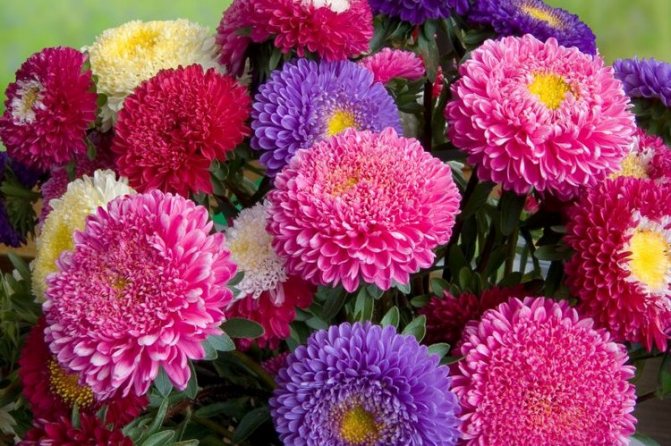

Agricultural technology or how you can plant asters - two ways
The cultivation of garden crops, flowers can take place in two ways - this is planting first seeds for seedlings, and then planting them in the ground in a greenhouse or on the street. Or immediately by a reckless method into flower beds and beds. Only not all plants can be grown using two methods at once, because the climate in our country cannot be called fertile, if only in the regions of the south. But the aster is also beautiful in that the reckless method can be used not only in warm regions, but also in a temperate zone. So, let's talk about both methods, and you choose the best one for yourself.
For information! The seedling method involves sowing seeds to obtain seedlings at home or in greenhouse conditions. Seedless is when crops are sown directly into the soil and no more transplanting is required, maximum picking.
How to choose or independently prepare aster seeds for planting seedlings
Today, on Internet sites and large, in a sense, garden stores, such as Auchan Garden, Leroy Merlin or OBI, aster seeds are represented by a huge variety of varieties and species, but you can also always collect them from your neighbors in the country or on flower beds in the city in the fall ... The main advantage of self-collection of planting material is its unconditional freshness and understandable quality.
Note! Aster seeds retain their germination ability for only 2 years.
How and when to collect aster seeds with your own hands?
The timing of the collection of aster seeds depends on its variety and species and usually falls somewhere around 45-65 days after the start of active flowering. Due to the fact that late-flowering varieties may delay their flowering until the first frost, it will be much easier to get seed from the buds of early asters, in which little children had time to form and mature well much earlier.
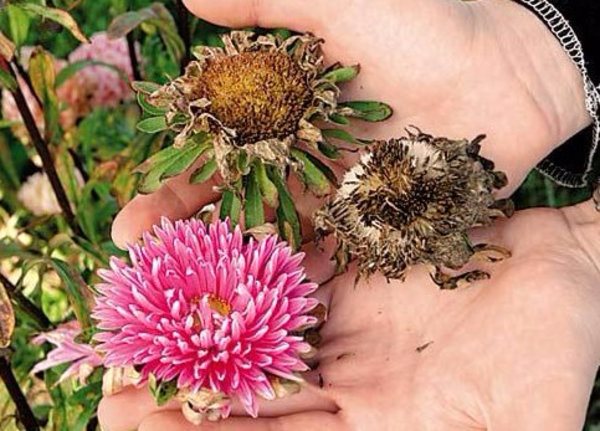

Therefore, in early varieties, dry baskets of formed inflorescences are used for seeds, collected only in sunny weather. You simply won't find them in the rain. The heads of late asters must be cut off in advance before the first subzero temperatures and stored at home until the buds wither.The best way is to transplant one of the bushes into a suitable container and bring the flower to maturity indoors. The collected seeds are wrapped in newspaper and stored in a dry and warm room.
Choosing a variety for planting
Asters are both perennial and annual.
Aster perennials can belong to three large varieties: spring (early), summer (middle) and autumn (late flowering).
The early flowering species includes the only aster (it blooms in May-June):
- Alpine.
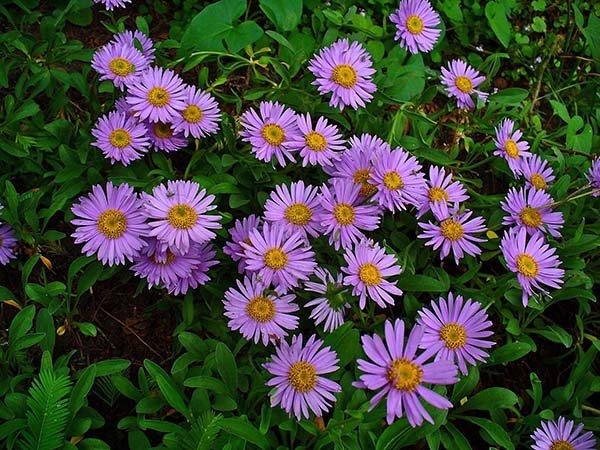

Medium flowering (bloom in July-August) are:
- Italian aster (chamomile);
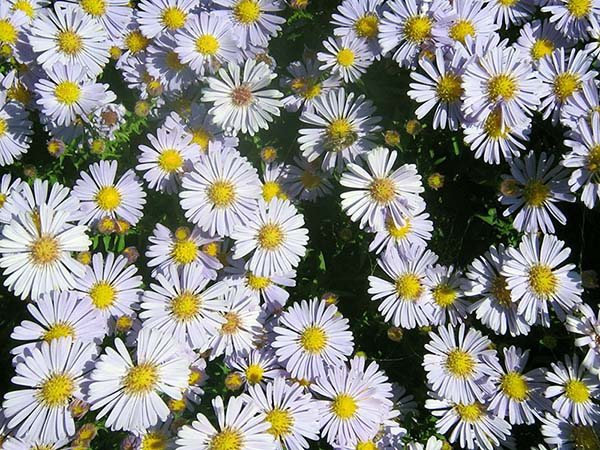

- Cleansing aster;
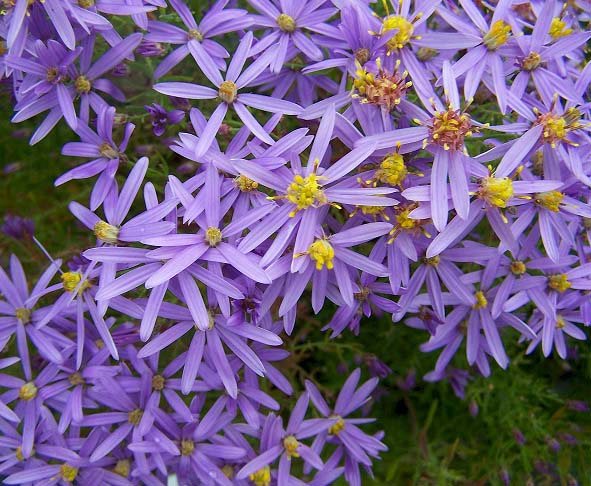

- Aster spread wide (corymbose);
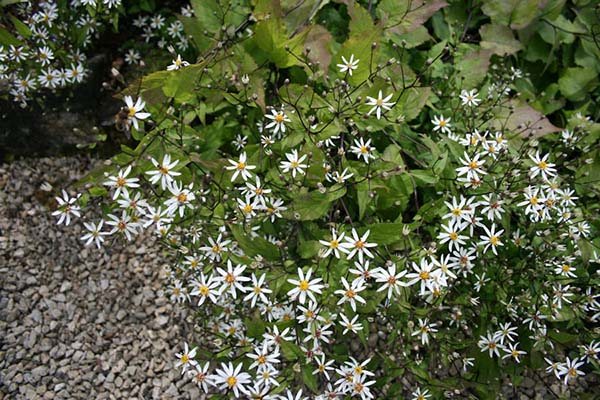

- Aster Bessarabian (false Italian).
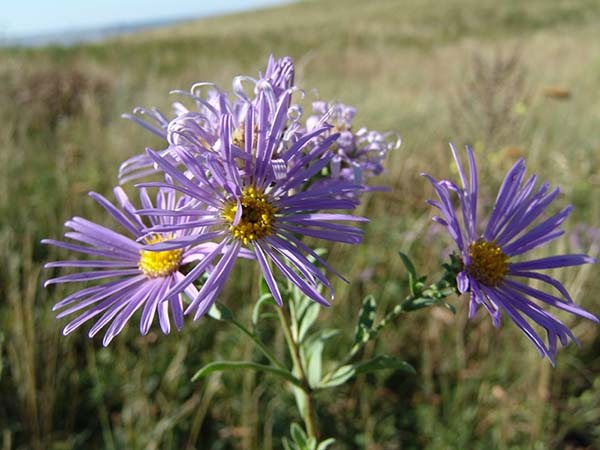

Late flowering (flowering occurs in September-November) are presented below:
- aster new belgian (virgin);
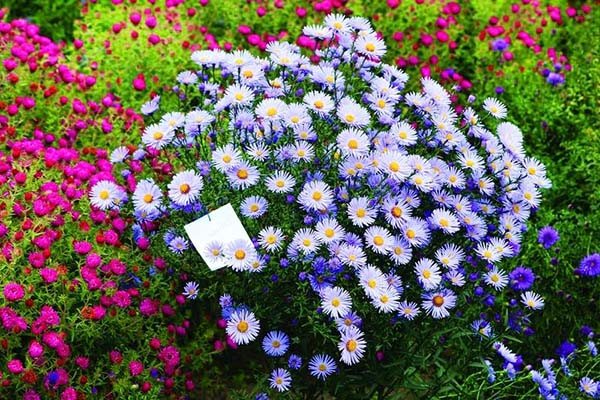

- shrub aster;
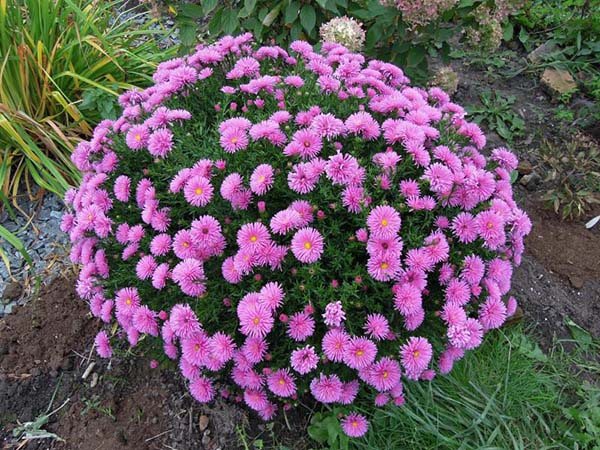

- aster heather ground cover;
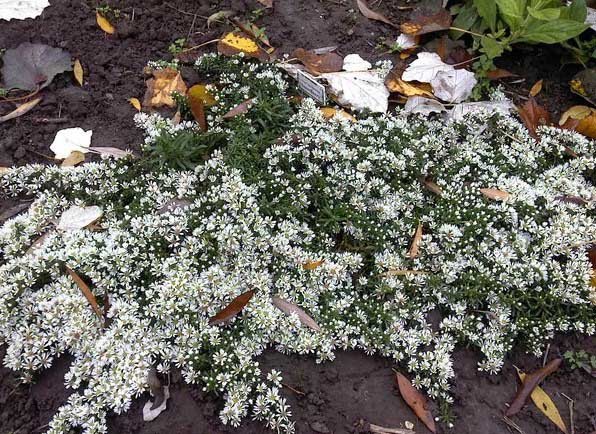

- New England aster (American).
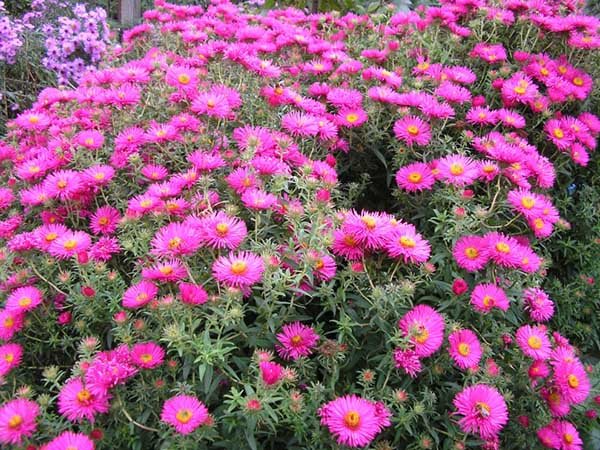

Annuals can be classified into short (up to 25 cm in height), medium and tall varieties (up to 80 cm).
So, undersized ones are ideal for ennobling paths in a country garden, flower beds, and also flower beds. Among them are: Royal dwarf aster, which belongs to the tiled type. The following varieties belong to the needle type: Baby curb, Summer, Vologda lace, Autumn Olympics and many others.
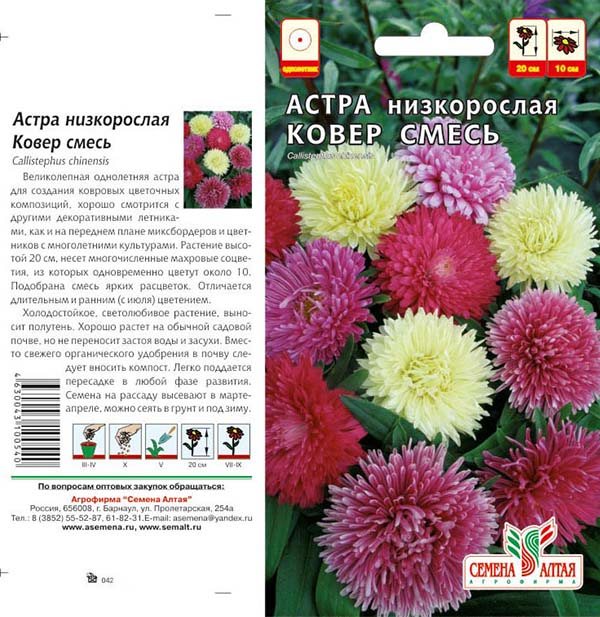

Tall ones, as a rule, are planted for the sake of their further cutting (for example, for sale), therefore they are planted in groups in separate specially organized flower beds.
Medium and tall varieties include peony asters: White and Blue Tower, Apollonia heavenly, Roseanne, Gala, Violet turm. Of the needles, it is worth especially mentioning: Naina, Assol, Carmona, Night Star, Belaya Nika, Timiryazevka, Jubilee White, Blue-eyed, Blue Frost, Isadora. Pom-poms are represented by the following varieties: Beatrice yellow, Hai-no-Maru, Winter cherry, Harlequin, Foyertot.
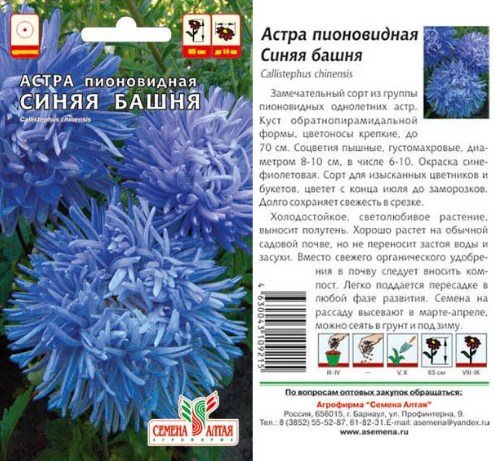

Fusarium aster wilting
Furazial wilting occurs most often in asters. The time of the lesion is very different, but mainly the disease occurs during the period of budding and flowering. It is quite simple to determine the problem, stripes of a brown tint appear on the stems, sometimes the entire stem can change color, curliness appears on the leaves. Basically, the lesion is carried out through the soil, which affects the root system.
Control methods recommended by experienced gardeners:
- First of all, attention should be paid to the seeds. Before planting, they are soaked for almost a day (16-19 hours) in a solution of micronutrient fertilizers.
- Before sowing, the soil is watered with a solution of potassium permanganate, with the calculation of 1.5 grams of the product per 10 liters of water.
- Sprinkle the seeds with sand (only dry).
- Diseased plants are disposed of in order to avoid further damage.
How asters breed
There are several options for how to propagate flowers.
Dividing the bush
Perennial asters are propagated by dividing the bush in the spring. It is not necessary to dig up bush asters, it is enough to divide it with a shovel. It is advisable to carry out the division process every 3-4 years, so the plant will rejuvenate and get rid of excess thickening, which contributes to damping off and the development of fungal diseases.
You can divide the bush into small parts with several buds. The next year, each part will become an independent plant.
Important! Each plot must have several shoots or a bud with roots.
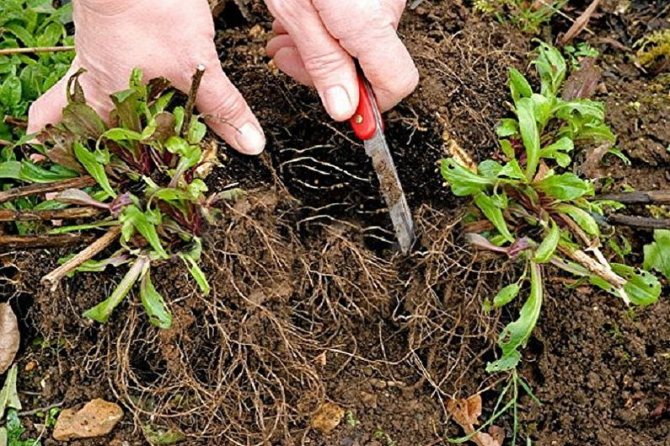

Division
Cuttings
Cuttings are carried out from May to August. The stem can be either the top of the stem or the entire stem. Choose a shaded place. Before planting asters, fertilize the garden with a mixture of turf, peat and sand in proportions of 2: 1: 1. The planted cuttings are covered with a film.
Collection and storage of seeds
A feature of asters is the ripening of seed material in 1.5-2 months from the moment the first inflorescences appear.In some cases, the time for harvesting grains falls on prolonged rains or autumn frosts, which often leads to the death of flowers.
Many gardeners cut the aster heads in advance and lay them on the windowsill, but such seed material does not always give good shoots.
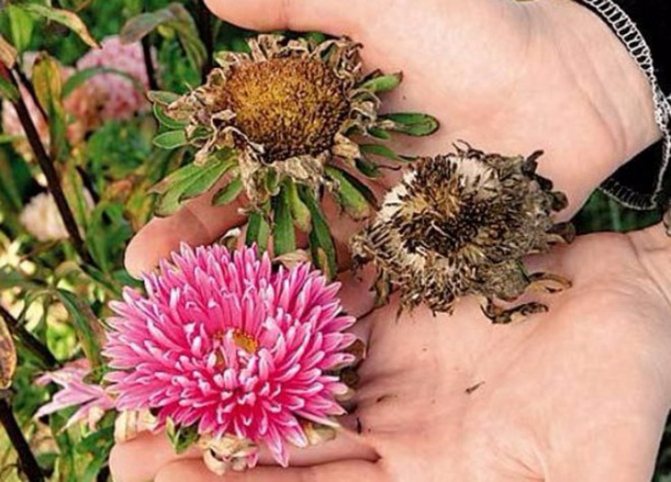

To preserve germination, it is necessary to dig up the plant and transplant it into a flowerpot, which is later installed on the windowsill. The culture will take about two or three weeks to mature. All this time, the bush needs to be rotated around an axis so that it receives a sufficient amount of sunlight.
After the inflorescences wither and the petals dry, a dark spot and fluff will appear in the center of the flower. At this time, you need to rip off the heads and place them in a paper bag, which should be stored in a dry and warm room. The packaging must indicate the date of seed collection, aster variety and color. We do not recommend storing the seeds for a long time, after two years their germination will decrease by 2.5 times.
Reproduction
Almost all asters breed easily:
- cuttings;
- dividing the bush;
- seeds.
Cuttings
Cuttings are carried out in the spring or summer months. Young shoots are cut from the bush at an acute angle, the leaves are cut off from them to reduce moisture evaporation. The section is treated with a solution of heteroauxin (chemical growth stimulant). Cuttings are added dropwise, covered with foil. When the plant takes root, the film is removed.
Dividing the bush
Reproduction by dividing the bush is carried out in the fall. This method is more suitable for plants that have reached the age of five years. Transplantation by division is simple: the flowers are dug up, carefully separated so as not to damage the root system, they are seated in the right places.
Seeds
How to collect aster seeds? To do this, you need to wait for all the petals to fade, darken the center of the flower and form a cannon in its middle. Such inflorescences need to be plucked, left to dry completely. The seeds are covered with a dense shell, due to which they remain viable for a long time (about 2 years).
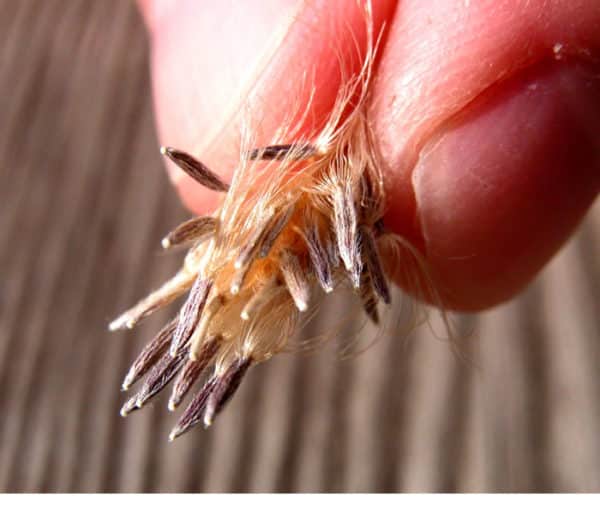

Over time, germination rates fall, so it is better to take fresh seeds.
Asters have faded - what to do
After the plants have faded, it is necessary to collect seeds from them, and dig up and burn the plants themselves, so that all possible pathogens of fungal and viral diseases are destroyed and do not have the opportunity to infect other plants.
The collected seeds can be planted in the soil in another area immediately after the first frost and sprinkled with peat or humus. In December-January, it is possible to carry out sub-winter sowing in furrows right in the snow. And in the spring, when the snow melts, the seeds must be covered with foil.
Garden asters after flowering
Post-flowering care depends on the species. So, seeds can be collected from annual plants, and dried remains of stems and flowers can be destroyed. Perennials are pruned after drying, dug up and divided if necessary, seated and covered with mulch for the winter.
Bloom
Flowering in various plant varieties begins 83–131 days after seed germination. Asters bloom until frost. But the exact time depends on the species - there are both early and late varieties that will bloom at different times:
- early - May – June;
- summer - July – August;
- autumn - September – November.


Asters cannot be cut off immediately after watering, otherwise the petals will quickly rot, the bouquet will lose its decorative effect.
How to care for aster so that it blooms longer? Do not forget to water, loosen the ground, destroy weeds and diseased flowers, treat plants with remedies for diseases and pests. A single inflorescence blooms for 20-40 days, the seeds ripen 35-40 days after flowering.
Planting seedlings in open ground
Seedlings are planted in the beds only when the threat of frost has passed. Asters, of course, will endure low temperatures, but then they will hurt for a long time. Their leaves begin to turn yellow, in addition, diseases join, and the plant eventually dies.If you can't do it and you have to plant the plants before the warm weather sets in, then cover the plants with covering material. Even before planting the plants in the ground, the soil is watered with Fitosporin, or treated with Fundazol for the prevention of fungal diseases.
For growing asters, choose bright, sunny places. The beds must be prepared in advance by seasoning the soil with well-rotted organic matter.
Be aware: asters do not tolerate fresh organic matter.
In the prepared soil, holes are made 7-10 cm deep. A little humus or compost can be placed on the bottom. Carefully remove the seedlings from the container and plant them in the prepared hole. Holding the plant with one hand, sprinkle the earth with the other and level the hole. The ground near the plant is lightly tamped, and then watered with water so that the soil settles a little to the roots. Plants are mulched immediately after transplanting. This will allow the soil to stay moist longer, weeds will not grow, and there is no need to loosen the soil.
Possible growing problems
What problems can a gardener face when growing asters?
Leaf problems
Leaves can turn yellow, lighten, dark stripes appear on them, swellings filled with spores can form. Eventually they curl up and dry out. All these are signs of an infection that has struck the plant.
Pests
Among the pests are:
- the slobbering penny produces a foam in which the larvae develop, devouring the leaves and stems of the flower. Because of this, growth slows down, and with severe damage, the plant dies. To combat the pest, tobacco decoction is used: 400 g is steamed in a bucket of water for 2 hours. Water is added to the finished decoction to 10 liters. A little laundry soap is also added so that the medicine sticks to the leaves;
- The meadow bug feeds on sap from flowers, stems and leaves, leaving behind white dots. To combat the parasite, the plant is sprayed with a solution of karbofos or pyrethrum;
- the spider mite also feeds on the sap of the plant, but settles on the back of the leaves, which is why they turn yellow and wither. To combat it, asters are sprayed with infusion of tobacco or onions. It can also be a decoction of yarrow;
- scoop gamma feeds on aerial parts of the plant. It is a caterpillar from which a brown butterfly with a pattern on the wings in the form of the Greek letter "gamma" hatches. Expelled by spraying with chlorophos or karbofos;
- bud aphids devour plants (especially tops) even at the seedling stage. To fight, spraying with chlorophos or karbofos is carried out.
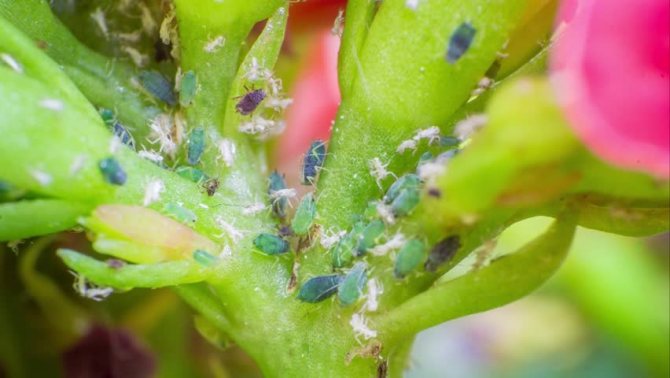

Aphid
Diseases
Possible diseases of asters:
- fusarium. The causative agent is a fungal infection. Viruses develop in the soil and enter the plant through the root system. The leaves begin to fade, turn yellow, curl, and dark spots appear. Appears quite rarely under favorable conditions (high temperatures). The affected plant must be removed, and the closely growing ones must be sprayed with a solution of copper oxychloride. Also, the soil is sprinkled with quicklime;
- blackleg. The causative agent is a fungal infection. Seedlings are affected: first they turn black, then the stem begins to rot. The diseased plant is removed, the rest are treated with a solution of bleach. The soil around the plants is sprinkled with sand;
- rust. Leaves swell on the back. Pustules filled with spores form. Affected plants are sprayed with a mixture of sulfur and lime in a 1: 1 ratio or Bordeaux liquid;
- jaundice. The causative agent is aphids and leafhoppers. Leaves begin to lighten and lose pigment. Growth slows down, the buds turn green. Affected plants are removed. To combat pathogens, spraying with pyrethrum or actellic is carried out. To prevent the disease, it is necessary to fight against aphids (spraying with a decoction or infusion of yarrow).
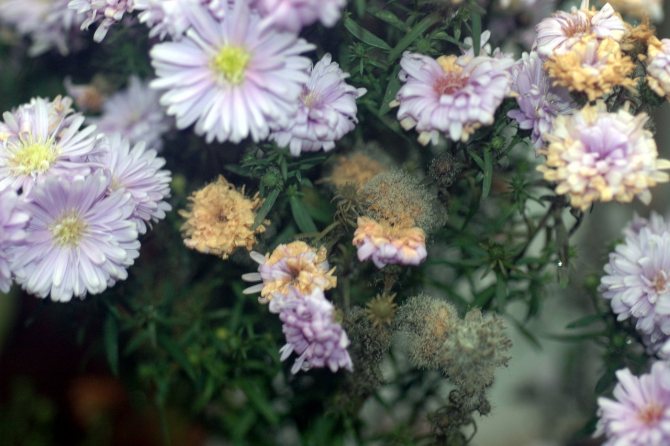

Disease
Signs of improper care
Although asters are considered unpretentious flowers, they still require some care.
- The flower is afraid of drought, but too much of it is also harmful: with a lack of water, the plant will dry out, with an excess, it will rot.
- Asters need weeding: this protects them from pests and diseases.
- The appearance of sores is also the result of improper maintenance or preparation of the soil.
In any case, asters are worth the time spent on them. The main thing is to choose a variety, plant it correctly and provide the required conditions. And then the flowers will delight the eye all summer until late autumn.
Aster pests
Against the misfortune of aphids and thrips on aster, they use an infusion and a decoction of yarrow. So, we prepare an infusion, pour boiling water from 800 grams of dry crushed stems and leaves, wash down 10 liters of water, insist for 36-48 hours, filter, then cool and apply.
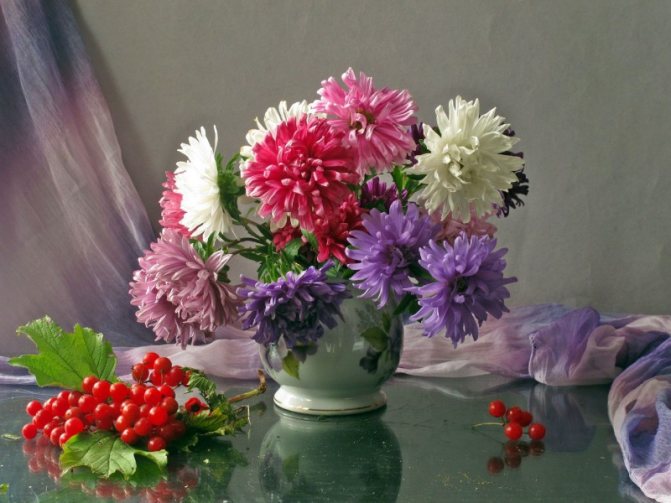

So, we made sure that asters are quite easy to plant and care for, so feel free to choose this flower for your flower beds. And remember, beloved women are given flowers, not tears! After all, happiness is not in the number of flowers donated, but happiness in the people who give them ...
loading ...

